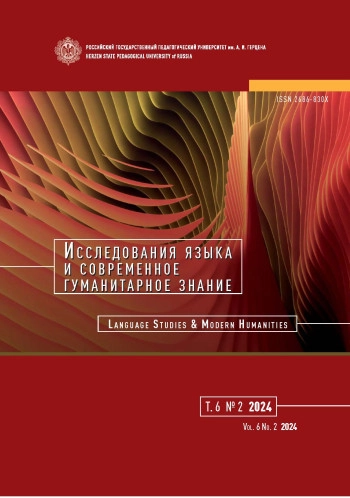1. Almazova, A. A., Erokhina, E. L., Chertov, V. F., Sharonova, O. V. (2022) Klyuchevye aspekty formirovaniya “myagkikh navykov” u budushchikh pedagogov [Key aspects of the formation of “soft skills” in future teachers]. Nauka i shkola - Science and School, no. 6, pp. 259-268. (In Russian). DOI: 10.31862/1819-463X-2022-6-259-268 EDN: HJEYLB
2. Chevtaeva, N. G., Nikitina, A. S., Vishnevskaya, A. V. (2020) Kul’tura kommunikatsii prepodavatelya i studenta kak matritsa formirovaniya “soft skills” vypusknika [Communication culture as a matrix for graduate’s “soft skills” development]. Vysshee obrazovanie v Rossii - Higher Education in Russia, vol. 29, no. 12, pp. 33-44. (In Russian). DOI: 10.31992/0869-3617-2020-29-12-33-44 EDN: HVSPLG
3. Donovan, B. (2024) Soft skills. Britannica money. [Online]. Available at: https://www.britannica.com/money/soft-skills (accessed 13.04.2024). (In English).
4. Ellis, R., Shintani, N. (2014) Exploring language pedagogy through second language acquisition research. London: Routledge Publ., 400 p. (In English). DOI: 10.4324/9780203796580
5. Kozyreva, L. D. (2021) Osnovnye trendy razvitiya soft skills [Main trends in the development of soft skills]. In: N. G. Skvortsov, R. V. Karapetyan (eds.). Transformatsiya truda v (de)globaliziruyushchemsya obshchestve: sbornik nauchnykh statej [Labor transformation in (de)globalizing society: Collection of scientific papers]. Saint Petersburg: Skifiya-print Publ., pp. 104-111. (In Russian).
6. Long, M. (2015) Second Language acquisition and task-based language teaching. Malden: Wiley-Blackwell Publ., 439 p. (In English).
7. McGrath, I. (2016) Materials evaluation and design for language teaching. 2nd ed. Edinburgh: Edinburgh University Press, 344 p. (In English).
8. Nunan, D. (1989) Designing tasks for the communicative classroom. Cambridge: Cambridge University Press, 211 p. (In English).
9. Paradis, M. (2004) A neurolinguistic theory of bilingualism. Amsterdam: John Benjamins Publ., 299 p. (In English). DOI: 10.1075/sibil.18
10. Powell, A. A. (2023) Nedostatki modeli “PPP” dlya razvitiya umenij spontannoi rechi i vozmozhnye puti ikh preodoleniya v aspekte nejrolingvisticheskikh, psikhologicheskikh i metodicheskikh obosnovanij [Drawbacks of the “PPP” model for the development of spontaneous speech skills and possible ways to overcome them on the basis of neuro-linguistic, psychological and methodical justifications]. In: I. S. Volegzhanina (ed.). Nepreryvnoe professional’noe obrazovanie: teoriya i praktika. Materialy XII Mezhdunarodnoj nauchno-prakticheskoj konferentsii [Continuing professional education: Theory and practice. Proceeding of the XII International scientific and practical conference]. Novosibirsk: Siberian Transport University Publ., pp. 129-140. (In Russian).
11. Skehan, P. (1996) Second language acquisition research and task-based instruction. In: J. Willis, D. Willis (eds.). Challenge and change in language teaching. Oxford: Heinemann Publ., pp. 17-30. (In English).
12. Skills for social progress: The power of social and emotional skills. (2015) OECD Skills Studies. [Online]. Available at: https://www.oecd.org/en/publications/skills-for-social-progress_9789264226159-en.html (accessed 13.04.2024). (In English).
13. Thaine, C., Thornbury, S. (2020) Off the page. Activities to bring lessons alive and enhance learning. Cambridge: Cambridge University Press, 304 p. (In English).
14. Tomlison, B. (2016) Achieving a match between SLA theory and materials development. In: SLA research and materials development for language learning. New York: Routledge Publ., pp. 3-22. (In English). DOI: 10.4324/9781315749082
15. Zimnyaya, I. A. (2009) Klyuchevye kompetentsii - novaya paradigma rezul’tata obrazovaniya [Key competences - a new paradigm of educational results]. Experiment i innovatsii v shkole, no. 2, pp. 7-14. (In Russian).








